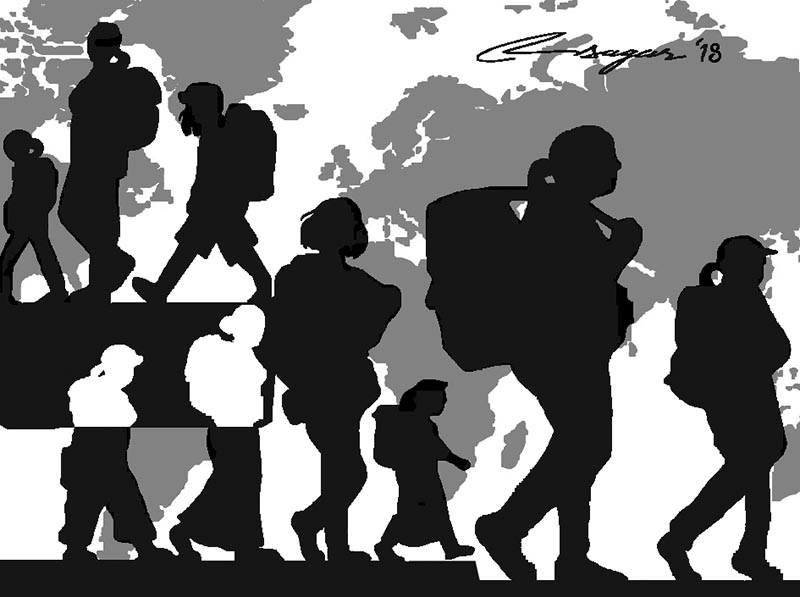Women labour migration: Causes and consequences
Studies suggest 80 per cent of Nepali women working abroad as domestic help are undocumented and reach destination countries through informal channels. There is a need to step up efforts to protect their labour rights
Migration of people from one place to another is a usual phenomenon. In the beginning of human civilisation, people used to migrate in search of food and to explore new places for safety and security. But in the course of time, migration has taken a diverse form. It has now become an essential part of society and considered a human right.
Migration and trafficking are a cross-cutting issue. Migration may take place through formal and informal channels and may be freely chosen or forced during the conflict and an economic crisis whereas trafficking in person denotes the movement of people for the purposes of exploiting their labour or service. Of late, trafficking of women has seen a surge in Nepal, which is a major cause for concern. Officially, only 4.68 per cent of Nepali migrant workers are women. However, according to an Amnesty International report (2011), women account for 30 per cent of the total number of Nepali migrant workers abroad. Likewise various studies suggest 80 per cent of Nepali women working abroad as domestic help are undocumented and travel to destination countries through informal channels via India, Bangladesh and recently from Sri Lanka.
Migrant workers are considered one of the major forces of development for many countries across the world. They contribute to economic progress and development of both receiving and sending countries. Women migrant workers’ issue, for the first time, has been incorporated in the Agenda 8 of the SDG 2030, especially the protection of their labour rights. However, they are subjected to various types of human rights violations such as forced labour, slavery, trafficking, sexual violence and rape, and sometimes even death.
Foreign labour migration is a major contributing factor in Nepal’s national economy. It ranks fourth in the world in terms of contribution of remittances to the gross domestic product (GDP, 28.3 per cent in 2017, World Bank, 2017). Remittance contributed to reduce poverty and mal-nutrition and support quality education and good housing in rural community.
Major causes of women migration are supposed to be economic complexity, political instability and patriarchal mindset. Here, focus has been given to patriarchal notion, for it underestimates women’s capacity and considers them as subordinate to men. The guardianship or protectionist approach that comes up with patriarchy may look good in the surface but in essence it obstructs the prosperity and development of women and teaches women to remain silent and submissive. It tries to hammer into women’s mind since childhood what is good and what is not. And hence women often tend to choose migration as a means to escape and survive. Different studies show women who were married off early or married to alcoholic husbands or married to economically and socially vulnerable persons often chose labour migration, as they neither had access to land (food) nor had support from husbands in household affairs. They have been facing harsh treatment, gender-based violence, domestic and sexual violence and injustice. And in search of a better life, they go abroad even if this entails risk. Unemployment, family debt, lack of awareness, peer pressure, illiteracy and false promises are other factors they prompt women labour migration.
The situation is further exacerbated by the weak implementation of Foreign Employment Act (FEA), 2007 and accompanying Rules (2008) which promote security and welfare of foreign migrant workers.
Due to illiteracy, many women can hardly read the contract paper and terms and conditions. Documents like citizenship, passport, visa, work permits, health certificates, insurance, air tickets and parental approval and other necessary official documents are handled/ prepared by “the agents”. Their plight snowballs when they reach destination countries, first of all due to language barrier.
The government of Nepal has signed bilateral labour agreements with seven major destination countries — Qatar, South Korea, UAE, Bahrain, Japan, Israel and Jordan. Agreements with several other countries are currently being discussed. Despite several positive steps taken by the government, challenges still remain when it comes to protecting the rights of migrant workers. To address these challenges, government should decrease the level of dependency on the private sector in foreign labour migration and take the lead to track labour demand and supply.
Rapid response teams with sufficient resources for rescue, repatriation, rehabilitation and reintegration in society should be developed. At least one safe house at state level, seven in all provinces, and 753 in local level must be established immediately to address the problems faced by the returnee migrant workers. If we forget to explore the alternative potential areas for youth involvement in self-employment sectors, we would not be able to achieve lasting peace and prosperity.
For sustainable solution, the state has to create employment opportunities at home in the areas where potential women migrant workers can be retained.
Chapagain is a human rights officer at National Human Rights Commission






